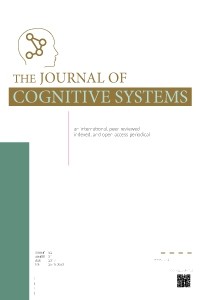THE SYNCHRONIZATION BEHAVIOR OF BASAL GANGLIA
THE SYNCHRONIZATION BEHAVIOR OF BASAL GANGLIA
basal ganglia synchronization,
___
- REFERENCES
- [1] T. Arakaki, “Collective dynamics of basal ganglia-thalamo-cortical loops and their roles in functions and dysfunctions”, Neurons and Cognition [q-bio.NC]. Université Pierre et Marie Curie - Paris VI, 2016. English.
- [2] Park , L. L. Rubchinsky, “Potential Mechanisms for Imperfect Synchronization in Parkinsonian Basal Ganglia”, PLOS ONE, Volume 7 , Issue 12, 2012 , pp. 1-12.
- [3] Galvan, A. Devergnas, T. Wichmann, “Alterations in neuronal activity in basal ganglia-thalamocortical circuits in the parkinsonian state”, Frontiers in Neuroanatomy, Vol. 9, Art. 5, 2015, pp.1-21.
- [4] Mandali, M. Rengaswam, V.S. Chakravarthy, A. A.Moustafa, “A spiking Basal Ganglia model of synchrony, exploration and decision making”, Frontiers in Neuroscience, Vol. 9, Art. 191, 2015 , pp.1-21.
- [5] W. D. Hutchison, J. O. Dostrovsky, J. R. Walters, R. Courtemanche, T. Boraud, J. Goldberg, P. Brown, “Neuronal Oscillations in the Basal Ganglia and Movement Disorders: Evidence from Whole Animal and Human Recordings”, The Journal of Neuroscience, 24(42), 2004 , pp. 9240 –9243.
- [6] T. Niikura, H. Tajima, Y. Kita, “Neuronal Cell Death in Alzheimer’s Disease and a Neuroprotective Factor, Humanin”, Current Neuropharmacology, 4, 2006, pp.139-147.
- [7] G. Kashyap, D. Bapat, D. Das, R.Gowaikar, R. E.Amritkar, G. Rangarajan, V. Ravindranath, G.Ambika, “Synapse loss and progress of Alzheimer’s disease -A network model”, Scientific Reports, 9: 6555, 2019, pp.1-9.
- [8] Liu, J. Wanga, H. Yua, B. Denga, X. Weia, H. Lic, K. A. Loparob, C. Fietkiewicz, “Dynamical analysis of Parkinsonian state emulated by hybrid Izhikevich neuron models”, Commun Nonlinear Sci Numer Simulat.,Vol. 28, 2015, pp. 10–26.
- [9] Y. Cakir, “Modeling influences of dopamine on synchronization behavior of striatum”, Network: Computation in Neural Systems, Vol. 28, No 1, 2017, pp. 28-52.
- [10] C.R. Gerfen, D.J. Surmeier, “Modulation of striatal projection systems by dopamine”, Annu Rev Neurosci., 34, 2011, pp. 441–466.
- [11] M.D. Humphries, J. Obeso, J.K. Dreyer, “Insights into Parkinson’s disease from computational models of the basal ganglia”, Neurol Neurosurg Psychiatry, 89, 2018, pp.1181–1188.
- [12] S. J. van Albada, P. A. Robinson, “Mean-field modeling of the basal ganglia-thalamocortical system. I Firing rates in healthy and parkinsonian states”, Journal of Theoretical Biology, Vol. 257, 2009, pp. 642–663.
- [13] E.M. Izhikevich, “Dynamical Systems in Neuroscience: The Geometry of Excitability and Bursting”, The MIT Press Cambridge, Massachusetts, London, England. 2007.
- [14] Y. Cakir, “Modeling of synchronization behavior of bursting neurons at nonlinearly coupled dynamical networks” Network: Computation in Neural Systems, Vol.27 No. 4, 2016, pp. 289-305.
- [15] D. Humphries, R. Wood, K. Gurney, “Dopamine-modulated dynamic cell assemblies generated by the GABAergic striatal microcircuit”, Neural Networks, Vol. 22, No. 8, 2009, pp. 1174-1188.
- [16] Guo, Q. Wang, M. Perc, “Complex synchronous behavior in interneuronal networks with delayed inhibitory and fast electrical synapses”, Phys Rev E., Vol. 85, 061905, 2012, pp. 1-8.
- [17] Hansel, H. Sompolinsky , “Synchronization and Computation in a Chaotic Neural Network”, Phys Rev Lett., Vol. 68, No. 5, 1992, pp.718–721.
- ISSN: 2548-0650
- Yayın Aralığı: Yılda 2 Sayı
- Başlangıç: 2016
- Yayıncı: İstanbul Teknik Üniversitesi
THE EFFECT OF THE ENVIRONMENT ON BRAIN ACTIVITY DURING PROBLEM SOLVING
Server Göksel ERALDEMİR, Mustafa Turan ARSLAN, Esen YILDIRIM, Filiz KOÇ
ARTIFICIAL INTELLIGENCE AND DEEP LEARNING METHODOLOGIES
THE SYNCHRONIZATION BEHAVIOR OF BASAL GANGLIA
A USABILITY RESEARCH ON TASK PREDICTION FOR EXPERIENCED USERS WITH COGTOOL
ELECTRICAL PROPERTIES OF THE NEURON AND ELECTRICAL MODELLING OF PASSIVE NEURON CELL MEMBRANE
